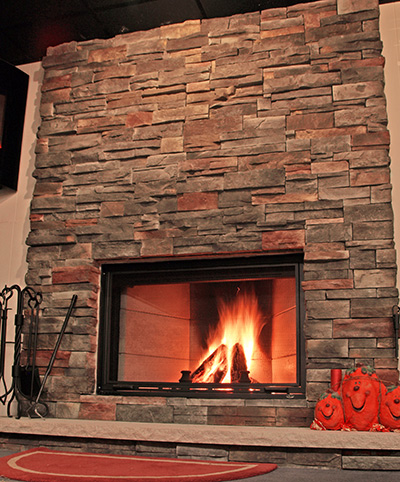Masonry vs. Factory-Built Fireplace
100 years ago, masonry fireplaces were the only option available for builders and homeowners. This is no longer true today. Whether you are building or remodeling, you have the option to decide between a traditional masonry fireplace or factory-built fireplace.
Today’s factory built-fireplaces can emulate the look of an old style fireplace so convincingly that some homeowners can hardly tell the difference. If you are considering adding a fireplace to your home, this information about the differences between these two types of fireplaces can help.
What are the Differences between types of Fireplaces?

Manufactured ZC Fireplaces combined with cultured stone surround can give the look of the old style masonry fireplace, but with much more energy efficiency.
Traditional masonry fireplaces are integrated into the architecture of a house. In most cases, they are constructed at the same time though one can be added when remodeling. As the name implies, they are made out of natural stone, cement blocks or brick and mortar. Most masonry fireplaces have a concrete foundation and all have a chimney that should be lined with a flue liner that is made out of tile, ceramic or steel. Since they are an integral part of a house, they must meet local building, engineering and municipal codes. These distinctive elements of a traditional fireplace make it a labor intensive and expensive addition to a home.
In contrast, factory-built or prefabricated fireplaces are designed and manufactured in a factory and arrive at your home ready to be installed. They are primarily made of metal, with glass doors, air-cooled pipes and insulated walls. One of the greatest advantages for homeowners is that factory-built fireplaces are made so that they can be installed after a home is constructed without the necessity of an extensive remodel. Though factory built fireplaces can also be installed when the home is built. While most factory built fireplaces require ventilation, their ventilation systems are less cumbersome than a chimney. All factory-built fireplaces are designed to meet municipal and engineering codes, though it is important to make sure that the model you choose adhere to your local codes. Their unique construction allows them to be placed in areas of the home where a masonry fireplace might not be allowed. An additional advantage is that factory-built fireplaces are more affordable to install even when you include the cost of a professional installation by a certified technician. Factory built fireplaces are also referred to as ZC (Zero Clearance) fireplaces since they can be vented up through wood construction in your home with less clearance area by building a framed chimney chase area that contains the venting chimney pipe. This specialized chimney pipe draws new air in and exhausts the smoke up and out the chimney. This means that a ZC Fireplace can be added nearly any place in your home where the space allows.
Heat Output
The improved heat output of factory built fireplaces is one of their greatest advantages. While on average traditional fireplaces only successfully radiate 10% of the heat that they produce into a home, factory-built fireplaces radiate 70% to 80%. The reason for this dramatic difference is that a factory-built fireplace is a closed combustion system. Because of the improved design and unique ventilation system, hot air produced by the fire is prevented from immediately escaping up the chimney as it does in a traditional fireplace. Fans within the fireplace also push heated air into your home. If you are considering adding a fireplace to your home because you would like an alternative heating source, a factory built fireplace is the best option. While a traditional fireplace hardly produces enough heat to warmup one room, a prefabricated fireplace can produce enough heat to zone-heat an entire floor depending on the model that you choose.
Factory built fireplaces are also far more energy efficient because of their closed combustion. This means that, if you choose a wood burning prefabricated fireplace, one load of wood will burn for significantly longer. You can enjoy making far less trips out to the wood pile along with paying smaller utilities bills because you are using your fireplace as an alternative heat source.
Average Lifetime
There is a significant difference between the average life of a factory-built fireplace and a masonry fireplace. Masonry fireplaces that have been properly designed can last for 50 to 100 years if they are cared for and maintained where as a factory-built fireplaces have an average lifetime of 10 to 20 years. The main reason that a factory-built fireplace reaches the end of its useful life earlier is because parts that need to be replaced because of the normal wear-and-tear of time or need to be repaired are no longer available after an extended length of time. Having your factory-built fireplace annually inspected and regularly serviced will increase its lifetime.
Long-term Costs
While the life of a factory built fireplace is significantly shorter than a traditional fireplace, repairing and replacing a factory built fireplace is usually much less expensive. A masonry fireplace that has been deteriorating because of water damage or has been damaged by a chimney fire can be prohibitively expensive to repair with the cost ranging in the thousands for replacement brick, stone or blocks, mortar and labor. Whereas repairing or replacing a factory-built fireplace may only cost you only a fraction of a masonry one. For many homeowners, it is far more practical to choose a fireplace that is less expensive to care for.
These four areas of distinction are the primary deciding factors for most homeowners when debating which type of fireplace to invest in. If you have more questions, please stop by Burlington’s! We are happy to talk to homeowners about fireplaces. We can show you a selection of factory-built fireplaces that illustrate the wide variety available. You can see for yourself if you think that a beautifully designed prefabricated fireplace is right for you or if you would prefer a masonry fireplace.
